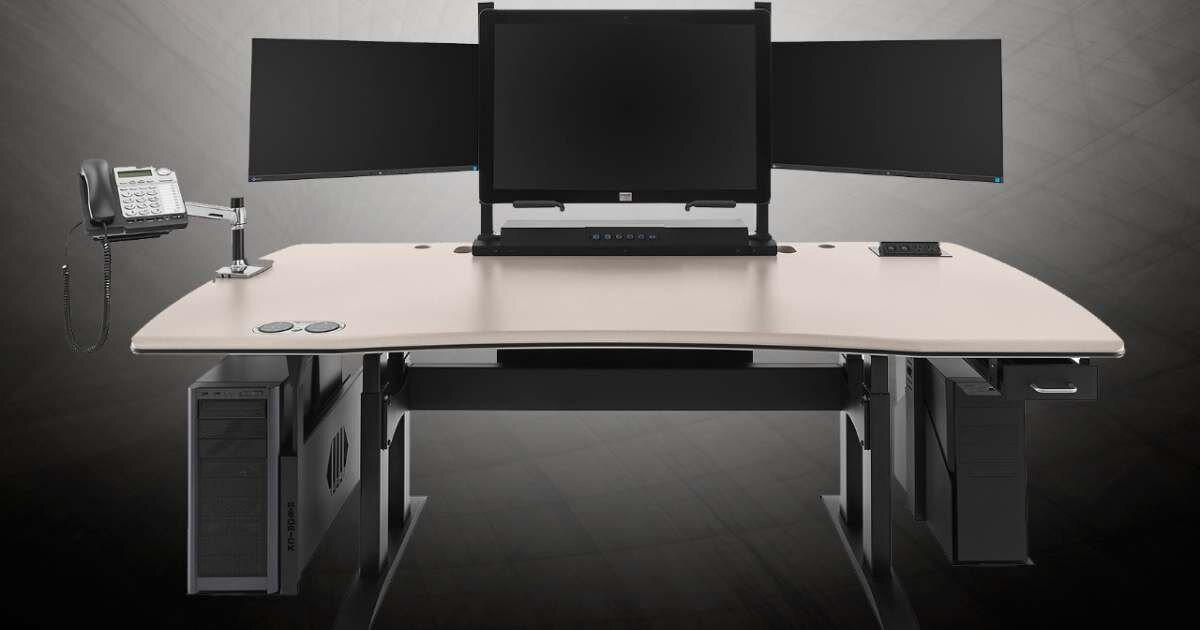
We collect basic website visitor information on this website and store it in cookies. We also utilize Google Analytics to track page view information to assist us in improving our website.

Radiologists play an important role in healthcare, interpreting complex imaging studies like X-rays and MRIs to guide diagnosis and treatment. As technology advances, they increasingly rely on digital tools and workstations, spending long hours in front of screens. This shift has led to an unfortunate rise in vision fatigue among radiologists.
Here, we will look at the causes and symptoms of vision fatigue, and its impact on radiologists’ performance, providing practical solutions to help alleviate this issue, ensuring both their mental and physical health is maintained to accurately diagnose patients.
At RedRick Technologies, we design and develop ergonomic workspaces for healthcare professionals that include workstations, monitor mounting solutions, accessories, and peripherals. We also provide ergonomic design services that help organizations implement ergonomic principles for improved space design and functionality. Get in touch and let’s find ways to improve the ergonomic functionality of your workspace.
Vision fatigue, which differs from general fatigue and sleepiness, involves eye strain, headaches, blurred vision, and difficulty focusing.
Unlike general fatigue, which borders on overall exhaustion, sleepiness, drowsiness, and decreased alertness, vision fatigue affects the eyes and visual processing.
This issue is especially problematic for radiologists due to their prolonged screen time and the need to interpret medical images precisely.
Studies reveal the extent of this problem. For instance, over 58% of radiologists report symptoms of repetitive strain injuries (RSIs), with a significant portion attributing these issues to extended computer use. Interpreting complex images requires long hours, which can lead to vision fatigue and potential misdiagnoses. Research indicates that a typical workday can lead to worse physical and mental restraints that make it more likely to miss abnormalities.
The demands of the job create high workloads, and the need for immediate interpretation further accelerates the problem, increasing the risk of visual fatigue. Understanding the problems radiologists face and how to address vision fatigue allows radiologists to excel at their jobs, resulting in safer patient outcomes.
Multiple components cause vision fatigue in radiologists. The most noticeable factor is the long hours radiologists spend sitting in front of a screen, closely examining images. Squinting at a screen for long periods is bound to cause impending eye strain.
The amount of focus required for image interpretation forces the eye muscles to work overtime, leading to visual exhaustion. High workloads, which are regular in a medical setting, demand that radiologists take fewer breaks, further aggravating eye strain.
Poor ergonomic setups in the workplace are one of the main factors contributing to vision fatigue. Improper lighting, poorly positioned monitors, and uncomfortable seating arrangements can all increase the strain on the eyes. Ergonomically unstable working conditions force radiologists to sit painfully in discomfort, adding to the physical strain on their bodies and eyes.
Fatigue has both physical and mental roadblocks. Physically, radiologists experience eye strain, headaches, and blurred vision. Mentally, long working periods and the inability to take breaks lead to decision fatigue and lowered concentration. Since the eyes can't focus properly, their ability to maintain sharpness leads to discomfort and inaccuracies.
Addressing the problems radiologists face when working is the leading solution to creating a more comfortable workspace. Implementing strategies for hospitals and healthcare facilities allows for improved ergonomics, encourages the need for regular breaks, and increases the likelihood of accurate diagnoses.
"Vision fatigue can manifest in a variety of ways, and these symptoms can increasingly affect a radiologist's ability to work and their overall well-being.
Eye strain is a main indicator defined by tiredness and discomfort. Strained eyes typically happen after prolonged screen time.
Headaches are another symptom of vision fatigue, and this can make it even harder for radiologists to focus on their work.
Blurred vision is another symptom that radiologists report. This makes it harder to see the smaller details, which are essential for making accurate diagnoses.
Dry eyes are also common, caused by reduced blinking during extended periods of focus. This condition can lead to irritation and a persistent sensation of dryness, making it uncomfortable to continue working.
Radiologists may also experience difficulty focusing, both visually and cognitively. This issue can slow the interpretation process and increase the likelihood of missing critical details in the images presented.
These symptoms collectively affect radiologist's performance by reducing their accuracy and speed in interpreting medical images. The strain on their visual and cognitive systems can increase errors, potentially compromising patient care.
The chronic nature of the symptoms can deteriorate their overall health, leading to long-term issues such as chronic headaches, persistent eye problems, and burnout.
Recognizing and addressing these symptoms is vital for maintaining the well-being and effectiveness of radiologists.
Vision fatigue can seriously impair radiologists' performance, leading to errors in image interpretation. When radiologists begin to experience visual strain, their ability to detect subtle abnormalities in medical images diminishes. This reduced accuracy is particularly concerning in a field where an accurate diagnosis is crucial for effective treatment planning.
Several studies have highlighted the link between fatigue and interpretive errors. Research by Krupinski and Berbaum found that radiologists' detection accuracy decreased significantly after a day of reading, with increased levels of visual strain and subjective fatigue. Another study showed that radiologists were more likely to make interpretive errors in the final hours of a long shift, further demonstrating the impact of fatigue on performance.
The implications for patient safety and care quality are profound. When radiologists miss critical details due to fatigue, the risk of misdiagnosis or delayed diagnosis increases. This can lead to inappropriate or delayed treatments, compromising patient outcomes. The pressure to maintain high productivity despite fatigue can exacerbate the problem, creating a cycle of reduced performance and increased strain.
Ensuring that radiologists can work in conditions that minimize fatigue is essential for maintaining high standards of patient care. By addressing the factors that contribute to vision fatigue, healthcare facilities can help radiologists maintain their performance and provide accurate, timely diagnoses.
Fortunately, radiologists can take steps to combat vision fatigue. Adopting preventive measures and ergonomic solutions can significantly improve their comfort and performance.

RedRick Technologies emphasizes the importance of a well-optimized workstation.
Screen settings, including brightness and contrast, should be adjusted to comfortable levels.
Proper lighting is essential; ambient lights should be mild and indirect to avoid glare, with manual lighting control for specific tasks.
Maintaining a comfortable room temperature also helps in reducing overall strain and fatigue.
Offering a range of ergonomic equipment, RedRick Technologies has designed tools to alleviate physical and visual strain.
Our ergonomic chairs feature adjustable lumbar support, ensuring radiologists can maintain a neutral spine position, reducing back and neck strain.
Adjustable desks, including sit-stand desks, allow radiologists to alternate between sitting and standing positions, promoting better circulation and reducing fatigue.
Monitor arms allow for precise positioning of screens, enabling the radiologist to adjust the height, distance, and angle of their monitors easily. This customization helps reduce eye strain and promotes a more comfortable viewing experience.
Finally, our specialized lighting solutions also ensure optimal illumination of workspaces, reducing glare and minimizing visual discomfort.
Regular breaks are vital in reducing eye strain. Radiologists should follow the 20-20-20 rule: every 20 minutes, take a 20-second break to look at something 20 feet away. This simple practice helps relax the eye muscles and prevents prolonged strain.
Scheduling regular short breaks throughout the workday can also help maintain mental and visual accuracy, reducing the risk of fatigue-related errors.
Incorporating eye exercises into a daily routine can significantly alleviate eye strain. Simple exercises, such as focusing on distant objects, rolling your eyes, and covering your eyes with your palms, can be very effective.
Conscious blinking is also crucial, especially since reduced blink rates are common during intense focus on screens. Regular blinking helps keep the eyes moist and reduces the risk of dry eyes.
At RedRick Technologies, we also emphasize the importance of educating radiologists about best practices for eye health.
Training programs that focus on ergonomic principles and personalized workstation setups can lead to significant improvements in comfort and performance.
Participatory ergonomics, where radiologists are involved in designing their work environment, ensures that the solutions are tailored to their specific needs and preferences.
Addressing vision fatigue in radiology is pivotal for radiologists’ physical and mental well-being to provide the best patient care possible. Long screen hours and precise image interpretation lead to significant strain, causing decreased performance and increased errors.
RedRick Technologies understands the impact of vision fatigue on radiologists. Our ergonomic solutions, such as adjustable monitors, supportive chairs, and well-designed lighting, are aimed at minimizing eye strain and promoting healthier work habits.
To get the most out of ergonomic improvements, it's also important to include education and training.
By implementing these solutions, radiologists can maintain a healthy work environment, prevent burnout, and safely diagnose patients. Creating a healthier work environment supports radiologists’ performance and enhances patient care exponentially.
Consult our ergonomic specialists and explore RedRick Technologies’ products to improve your workstation setup.